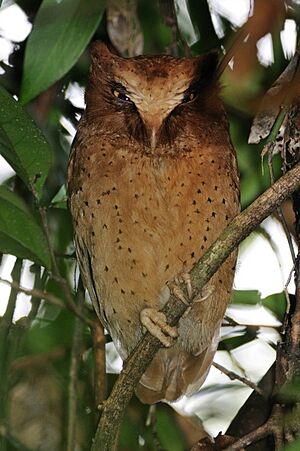Serendib scops owl facts for kids
Quick facts for kids Serendib scops owl |
|
|---|---|
 |
|
| Serendib scops owl | |
| Conservation status | |
| Scientific classification | |
| Genus: |
Otus
|
| Species: |
thilohoffmanni
|
The Serendib scops owl (Otus thilohoffmanni) is a small owl that lives in Sri Lanka. It is special because it was the most recently discovered bird in Sri Lanka.
A famous Sri Lankan bird expert, Deepal Warakagoda, first heard its unusual poo-ooo call in the Kitulgala rainforest. This was in 1995. Six years later, on January 23, 2001, he finally saw the owl in the Sinharaja area. Scientists officially described it as a brand new species in 2004. Besides Sinharaja and Kitulgala, this owl has also been found in a few other places like Runakanda Reserve and Eratna Gilimale. In the Sinhala language, it is called පඩුවන් බස්සා.
This owl is the first new bird species found in Sri Lanka since 1868. That's when the Sri Lanka whistling thrush was discovered! The Serendib scops owl is also an endemic species. This means it lives naturally only in Sri Lanka and nowhere else in the world. It is one of about 24 to 27 bird species unique to the island.
Where it Lives and What it Does
The Serendib scops owl lives in the rainforests in the southern part of Sri Lanka. It can be found at low elevations, usually between 30 and 50 meters above sea level. This owl does not compete with other owls for food or space. This is because other nocturnal (night-active) birds live in different areas.
This owl species has a very small population. In early 2006, only about 80 of these owls were known to exist. They are thought to live in five protected areas, like forest reserves, in Sri Lanka. Their numbers seem to be going down. This is mainly because their forest homes are being lost or damaged.
Like most owls, the Serendib scops owl is active only at night. It hunts for insects, such as beetles and moths, close to the ground. It starts calling when the sun goes down. Its calls become more frequent again about two hours before the sun comes up.
What Does it Look Like?
The Serendib scops owl is about 16.5 centimeters (about 6.5 inches) long. It has a short tail. Its body is reddish-brown with lighter colors on its belly. It has fine black spots all over its feathers.
Unlike two other types of scops owls found in Sri Lanka, the Indian scops owl and the oriental scops owl, the Serendib scops owl does not have ear-tufts. Ear-tufts are feather tufts that look like ears. Also, its face, called a facial disc, is not very clearly defined.
The owl's eyes, called irides, are a yellowish-brown color. The male owls tend to have more orange in their eyes. Its feet are a pale, fleshy color. The upper part of its legs, called tarsi, have feathers covering less than half their length. Its claws and beak are a pale ivory color.
Is it a Unique Species?
For a while, some bird experts in Sri Lanka wondered if the Serendib scops owl was truly a separate species. They also questioned if it was a new discovery or if it had been seen before.
However, after more study, scientists now agree that the Serendib scops owl is a real and unique species. Even some of the experts who had questions earlier now recognize it as a distinct type of owl. This was confirmed in books like Birds of Sri Lanka: A Tally List (2009) and An Illustrated Guide to the Birds of Sri Lanka (2010).
In Culture
This special bird is featured on the 20 Sri Lankan rupee bank note. You can see it on the series of notes released in 2010.


